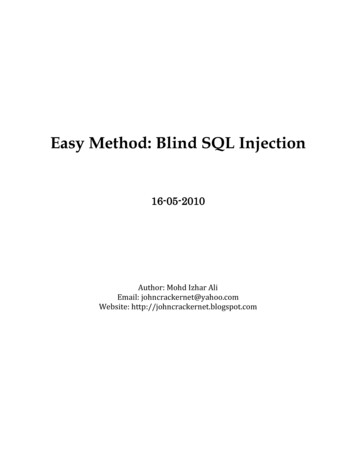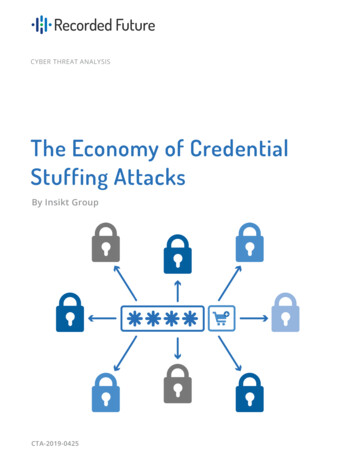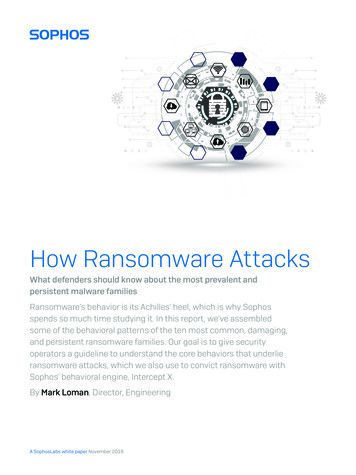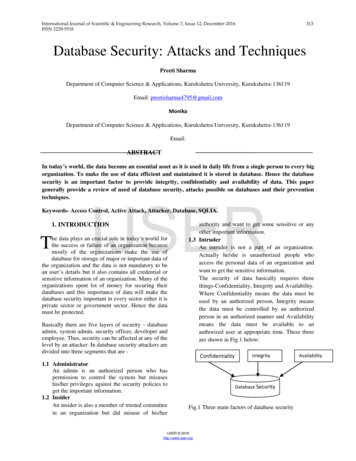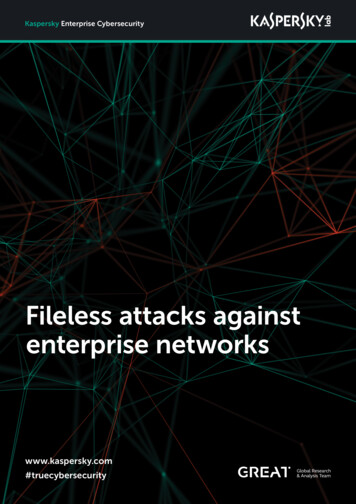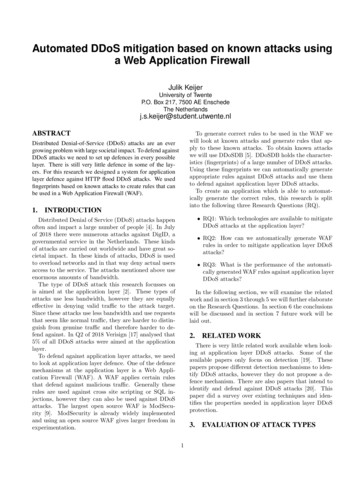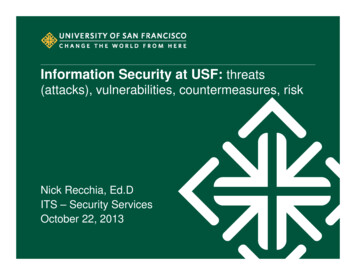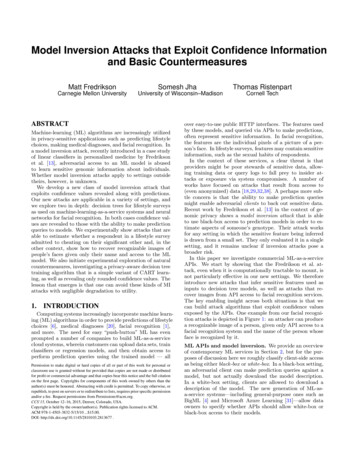
Transcription
Model Inversion Attacks that Exploit Confidence Informationand Basic CountermeasuresMatt FredriksonCarnegie Mellon UniversitySomesh JhaUniversity of Wisconsin–MadisonABSTRACTMachine-learning (ML) algorithms are increasingly utilizedin privacy-sensitive applications such as predicting lifestylechoices, making medical diagnoses, and facial recognition. Ina model inversion attack, recently introduced in a case studyof linear classifiers in personalized medicine by Fredriksonet al. [13], adversarial access to an ML model is abusedto learn sensitive genomic information about individuals.Whether model inversion attacks apply to settings outsidetheirs, however, is unknown.We develop a new class of model inversion attack thatexploits confidence values revealed along with predictions.Our new attacks are applicable in a variety of settings, andwe explore two in depth: decision trees for lifestyle surveysas used on machine-learning-as-a-service systems and neuralnetworks for facial recognition. In both cases confidence values are revealed to those with the ability to make predictionqueries to models. We experimentally show attacks that areable to estimate whether a respondent in a lifestyle surveyadmitted to cheating on their significant other and, in theother context, show how to recover recognizable images ofpeople’s faces given only their name and access to the MLmodel. We also initiate experimental exploration of naturalcountermeasures, investigating a privacy-aware decision treetraining algorithm that is a simple variant of CART learning, as well as revealing only rounded confidence values. Thelesson that emerges is that one can avoid these kinds of MIattacks with negligible degradation to utility.1.INTRODUCTIONComputing systems increasingly incorporate machine learning (ML) algorithms in order to provide predictions of lifestylechoices [6], medical diagnoses [20], facial recognition [1],and more. The need for easy “push-button” ML has evenprompted a number of companies to build ML-as-a-servicecloud systems, wherein customers can upload data sets, trainclassifiers or regression models, and then obtain access toperform prediction queries using the trained model — allPermission to make digital or hard copies of all or part of this work for personal orclassroom use is granted without fee provided that copies are not made or distributedfor profit or commercial advantage and that copies bear this notice and the full citationon the first page. Copyrights for components of this work owned by others than theauthor(s) must be honored. Abstracting with credit is permitted. To copy otherwise, orrepublish, to post on servers or to redistribute to lists, requires prior specific permissionand/or a fee. Request permissions from Permissions@acm.org.CCS’15, October 12–16, 2015, Denver, Colorado, USA.Copyright is held by the owner/author(s). Publication rights licensed to ACM.ACM 978-1-4503-3832-5/15/10 . 15.00.DOI: http://dx.doi.org/10.1145/2810103.2813677 .Thomas RistenpartCornell Techover easy-to-use public HTTP interfaces. The features usedby these models, and queried via APIs to make predictions,often represent sensitive information. In facial recognition,the features are the individual pixels of a picture of a person’s face. In lifestyle surveys, features may contain sensitiveinformation, such as the sexual habits of respondents.In the context of these services, a clear threat is thatproviders might be poor stewards of sensitive data, allowing training data or query logs to fall prey to insider attacks or exposure via system compromises. A number ofworks have focused on attacks that result from access to(even anonymized) data [18,29,32,38]. A perhaps more subtle concern is that the ability to make prediction queriesmight enable adversarial clients to back out sensitive data.Recent work by Fredrikson et al. [13] in the context of genomic privacy shows a model inversion attack that is ableto use black-box access to prediction models in order to estimate aspects of someone’s genotype. Their attack worksfor any setting in which the sensitive feature being inferredis drawn from a small set. They only evaluated it in a singlesetting, and it remains unclear if inversion attacks pose abroader risk.In this paper we investigate commercial ML-as-a-serviceAPIs. We start by showing that the Fredrikson et al. attack, even when it is computationally tractable to mount, isnot particularly effective in our new settings. We thereforeintroduce new attacks that infer sensitive features used asinputs to decision tree models, as well as attacks that recover images from API access to facial recognition services.The key enabling insight across both situations is that wecan build attack algorithms that exploit confidence valuesexposed by the APIs. One example from our facial recognition attacks is depicted in Figure 1: an attacker can producea recognizable image of a person, given only API access to afacial recognition system and the name of the person whoseface is recognized by it.ML APIs and model inversion. We provide an overviewof contemporary ML services in Section 2, but for the purposes of discussion here we roughly classify client-side accessas being either black-box or white-box. In a black-box setting,an adversarial client can make prediction queries against amodel, but not actually download the model description.In a white-box setting, clients are allowed to download adescription of the model. The new generation of ML-asa-service systems—including general-purpose ones such asBigML [4] and Microsoft Azure Learning [31]—allow dataowners to specify whether APIs should allow white-box orblack-box access to their models.
Our new estimator, as well as the Fredrikson et al. one,query or run predictions a number of times that is linearin the number of possible values of the target sensitive feature(s). Thus they do not extend to settings where featureshave exponentially large domains, or when we want to inverta large number of features from small domains.Figure 1: An image recovered using a new model inversion attack (left) and a training set image of thevictim (right). The attacker is given only the person’s name and access to a facial recognition systemthat returns a class confidence score.Consider a model defining a function f that takes input afeature vector x1 , . . . , xd for some feature dimension d andoutputs a prediction y f (x1 , . . . , xd ). In the model inversion attack of Fredrikson et al. [13], an adversarial clientuses black-box access to f to infer a sensitive feature, sayx1 , given some knowledge about the other features and thedependent value y, error statistics regarding the model, andmarginal priors for individual variables. Their algorithm isa maximum a posteriori (MAP) estimator that picks thevalue for x1 which maximizes the probability of having observed the known values (under some seemingly reasonableindependence assumptions). To do so, however, requirescomputing f (x1 , . . . , xd ) for every possible value of x1 (andany other unknown features). This limits its applicabilityto settings where x1 takes on only a limited set of possiblevalues.Our first contribution is evaluating their MAP estimator in a new context. We perform a case study showingthat it provides only limited effectiveness in estimating sensitive features (marital infidelity and pornographic viewinghabits) in decision-tree models currently hosted on BigML’smodel gallery [4]. In particular the false positive rate is toohigh: our experiments show that the Fredrikson et al. algorithm would incorrectly conclude, for example, that a person (known to be in the training set) watched pornographicvideos in the past year almost 60% of the time. This mightsuggest that inversion is not a significant risk, but in fact weshow new attacks that can significantly improve inversionefficacy.White-box decision tree attacks. Investigating the actual data available via the BigML service APIs, one sees thatmodel descriptions include more information than leveragedin the black-box attack. In particular, they provide thecount of instances from the training set that match eachpath in the decision tree. Dividing by the total number ofinstances gives a confidence in the classification. While apriori this additional information may seem innocuous, weshow that it can in fact be exploited.We give a new MAP estimator that uses the confidenceinformation in the white-box setting to infer sensitive information with no false positives when tested against twodifferent BigML decision tree models. This high precisionholds for target subjects who are known to be in the trainingdata, while the estimator’s precision is significantly worsefor those not in the training data set. This demonstratesthat publishing these models poses a privacy risk for thosecontributing to the training data.Extracting faces from neural networks. An exampleof a tricky setting with large-dimension, large-domain datais facial recognition: features are vectors of floating-pointpixel data. In theory, a solution to this large-domain inversion problem might enable, for example, an attacker touse a facial recognition API to recover an image of a persongiven just their name (the class label). Of course this wouldseem impossible in the black-box setting if the API returnsanswers to queries that are just a class label. Inspecting facial recognition APIs, it turns out that it is common to givefloating-point confidence measures along with the class label(person’s name). This enables us to craft attacks that castthe inversion task as an optimization problem: find the inputthat maximizes the returned confidence, subject to the classification also matching the target. We give an algorithm forsolving this problem that uses gradient descent along withmodifications specific to this domain. It is efficient, despitethe exponentially large search space: reconstruction completes in as few as 1.4 seconds in many cases, and in 10–20minutes for more complex models in the white-box setting.We apply this attack to a number of typical neural networkstyle facial recognition algorithms, including a softmax classifier, a multilayer perceptron, and a stacked denoising autoencoder. As can be seen in Figure 1, the recovered imageis not perfect. To quantify efficacy, we perform experimentsusing Amazon’s Mechanical Turk to see if humans can usethe recovered image to correctly pick the target person out ofa line up. Skilled humans (defined in Section 5) can correctlydo so for the softmax classifier with close to 95% accuracy(average performance across all workers is above 80%). Theresults are worse for the other two algorithms, but still beatrandom guessing by a large amount. We also investigate related attacks in the facial recognition setting, such as usingmodel inversion to help identify a person given a blurred-outpicture of their face.Countermeasures. We provide a preliminary explorationof countermeasures. We show empirically that simple mechanisms including taking sensitive features into account whileusing training decision trees and rounding reported confidence values can drastically reduce the effectiveness of ourattacks. We have not yet evaluated whether MI attacksmight be adapted to these countermeasures, and this suggests the need for future research on MI-resistant ML.Summary. We explore privacy issues in ML APIs, showingthat confidence information can be exploited by adversarial clients in order to mount model inversion attacks. Weprovide new model inversion algorithms that can be usedto infer sensitive features from decision trees hosted on MLservices, or to extract images of training subjects from facialrecognition models. We evaluate these attacks on real data,and show that models trained over datasets involving surveyrespondents pose significant risks to feature confidentiality,and that recognizable images of people’s faces can be extracted from facial recognition models. We evaluate preliminary countermeasures that mitigate the attacks we develop,and might help prevent future attacks.
2.BACKGROUNDOur focus is on systems that incorporate machine learningmodels and the potential confidentiality threats that arisewhen adversaries can obtain access to these models.ML basics. For our purposes, an ML model is simply adeterministic function f : Rd 7 Y from d features to a setof responses Y . When Y is a finite set, such as the namesof people in the case of facial recognition, we refer to f as aclassifier and call the elements in Y the classes. If insteadY R, then f is a regression model or simply a regression.Many classifiers, and particularly the facial recognitionones we target in Section 5, first compute one or more regressions on the feature vector for each class, with the corresponding outputs representing estimates of the likelihoodthat the feature vector should be associated with a class.These outputs are often called confidences, and the classification is obtained by choosing the class label for the regression with highest confidence. More formally, we definef in these cases as the composition of two functions. Thefirst is a function f : Rd 7 [0, 1]m where m is a parameter specifying the number of confidences. For our purposesm Y 1, i.e., one less than the number of class labels.The second function is a selection function t : [0, 1]m Ythat, for example when m 1, might output one label ifthe input is above 0.5 and another label otherwise. Whenm 1, t may output the label whose associated confidenceis greatest. Ultimately f (x) t(f (x)). It is common amongAPIs for such models that classification queries return bothf (x) as well as f (x). This provides feedback on the model’sconfidence in its classification. Unless otherwise noted wewill assume both are returned from a query to f , with theimplied abuse of notation.One generates a model f via some (randomized) trainingalgorithm train. It takes as input labeled training data db, asequence of (d 1)-dimensional vectors (x, y) Rd Y wherex x1 , . . . , xd is the set of features and y is the label. Werefer to such a pair as an instance, and typically we assumethat instances are drawn independently from some prior distribution that is joint over the features and responses. Theoutput of train is the model1 f and some auxiliary information aux. Examples of auxiliary information might includeerror statistics and/or marginal priors for the training data.ML APIs. Systems that incorporate models f will do sovia well-defined application-programming interfaces (APIs).The recent trend towards ML-as-a-service systems exemplifies this model, where users upload their training datadb and subsequently use such an API to query a modeltrained by the service. The API is typically provided overHTTP(S). There are currently a number of such services,including Microsoft Machine Learning [31], Google’s Prediction API [16], BigML [4], Wise.io [40], that focus on analytics. Others [21,26,36] focus on ML for facial detection andrecognition.Some of these services have marketplaces within whichusers can make models or data sets available to other users.A model can be white-box, meaning anyone can downloada description of f suitable to run it locally, or black-box,meaning one cannot download the model but can only make1We abuse notation and write f to denote both the functionand an efficient representation of it.prediction queries against it. Most services charge by thenumber of prediction queries made [4,16,31,36].Threat model. We focus on settings in which an adversarial client seeks to abuse access to an ML model API.The adversary is assumed to have whatever information theAPI exposes. In a white-box setting this means access todownload a model f . In a black-box setting, the attackerhas only the ability to make prediction queries on featurevectors of the adversary’s choosing. These queries can beadaptive, however, meaning queried features can be a function of previously retrieved predictions. In both settings, theadversary obtains the auxiliary information aux output bytraining, which reflects the fact that in ML APIs this datais currently most often made public.2We will focus on contexts in which the adversary doesnot have access to the training data db, nor the ability tosample from the joint prior. While in some cases trainingdata is public, our focus will be on considering settings withconfidentiality risks, where db may be medical data, lifestylesurveys, or images for facial recognition. Thus, the adversary’s only insight on this data is indirect, through the MLAPI.We do not consider malicious service providers, and wedo not consider adversarial clients that can compromise theservice, e.g., bypassing authentication somehow or otherwiseexploiting a bug in the server’s software. Such threats areimportant for the security of ML services, but already knownas important issues. On the other hand, we believe that thekinds of attacks we will show against ML APIs are moresubtle and unrecognized as threats.3.THE FREDRIKSON ET AL. ATTACKWe start by recalling the generic model inversion attackfor target features with small domains from Fredrikson etal. [13].Fredrikson et al. considered a linear regression model fthat predicted a real-valued suggested initial dose of thedrug Warfarin using a feature vector consisting of patient demographic information, medical history, and genetic markers.3 The sensitive attribute was considered to be the genetic marker, which we assume for simplicity to be the firstfeature x1 . They explored model inversion where an attacker, given white-box access to f and auxiliary informadeftion side(x, y) (x2 , . . . , xt , y) for a patient instance (x, y),attempts to infer the patient’s genetic marker x1 .Figure 2 gives their inversion algorithm. Here we assumeaux gives the empirically computed standard deviation σfor a Gaussian error model err and marginal priors p (p1 , . . . , pt ). The marginal prior pi is computed by firstpartitioning the real line into disjoint buckets (ranges of values), and then letting pi (v) for each bucket v be the thenumber of times xi falls in v over all x in db divided by thenumber of training vectors db .In words, the algorithm simply completes the target feature vector with each of the possible values for x1 , and thencomputes a weighted probability estimate that this is thecorrect value. The Gaussian error model will penalize val2For example, BigML.io includes this data on web pagesdescribing black-box models in their model gallery [4].3The inputs were processed in a standard way to make nominal valued data real-valued. See [13] for details.
adversary Af (err, pi , x2 , . . . , xt , y):1: for each possible value v of x1 do2:x0 (v, x2 , . . . , xt ) Q3:rv err(y, f (x0 )) · i pi (xi )4: Return arg maxv rvφ1 (x) x1w1 0φ2 (x) (1 x1 )(x2 )w2 1φ3 (x) (1 x1 )(1 x2 ) w3 0x1010x2011Figure 2: Generic inversion attack for nominal target features.ues of x1 that force the prediction to be far from the givenlabel y.As argued in their work, this algorithm produces the leastbiased maximum a posteriori (MAP) estimate for x1 giventhe available information. Thus, it minimizes the adversary’s misprediction rate. They only analyzed its efficacy inthe case of Warfarin dosing, showing that the MI algorithmabove achieves accuracy in predicting a genetic marker closeto that of a linear model trained directly from the originaldata set.It is easy to see that their algorithm is, in fact, blackbox, and in fact agnostic to the way f works. That meansit is potentially applicable in other settings, where f is nota linear regression model but some other algorithm. Anobvious extension handles a larger set of unknown features,simply by changing the main loop to iterate over all possiblecombinations of values for the unknown features. Of coursethis only makes sense for combinations of nominal-valuedfeatures, and not truly real-valued features.Howe
Figure 1: An image recovered using a new model in-version attack (left) and a training set image o
